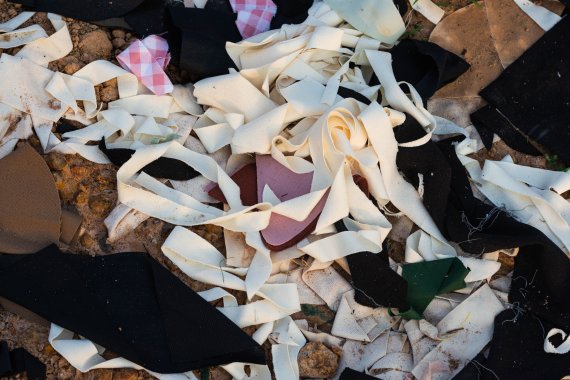Synthetics remain the majority fiber stake in the recently published Materials Market Report from Textile Exchange; global fiber production reached an all-time high of 124 million tonnes in 2023. Polyester alone accounted for 57 percent of total fiber production, including recycled and virgin fiber. So, the takeaway from this news is that synthetics are here to stay. Development continues in recycled fiber, but slowly due to limitations in recycled technology. Bio-based developments also continue.
One of the leading environmental issues is microplastic pollution, which are found in our environment, food, and bodies. Fibers shed from synthetic textiles, commonly referred to as “synthetic microfiber pollution” are the most prevalent form of microplastic pollution in environments worldwide. So what can be done about this? When you first hear the term biodegradable polyester and nylon, your brain does a bit of a freeze. How is this possible? Is it an oxymoron?
Yes, we have bio-based synthetics, but are they biodegradable? Does this mean that, as consumers, we can lead a guilt-free existence by throwing biodegradable synthetic clothes away at the end of their life? Well, the answer is no: the biodegradable capability now available is more a response to the increased problem of microfiber pollution than to the quick biodegradability of a garment.
It has been a long time coming, but a new development is gaining traction in the performance fabric sector, which relies heavily on synthetics due to their affordability, availability, durability, strength, and easy care. Microfiber pollution is one of the bugbears that mistakenly fall into the synthetic field but is also more accurately referred to as “fiber fragmentation pollution”, as it isn’t just synthetics that pollute the environment but also natural fibers. Yet, due to the chemistry used in the dyeing and finishing, they don’t necessarily biodegrade as you would expect them to.
Ciclo is one of the pioneering solutions for synthetic fiber pollution, and ISPO caught up with Andrea Ferris, CEO of Intrinsic Advanced Materials, to learn more about the biodegradable synthetic ingredient.
What is interesting is that this technology isn’t new, it was developed starting over a decade ago when Ferris was working for a uniforms company, and managing the McDonald's uniforms program in the U.S. Although the program had already incorporated recycled polyester, perfect for the rigors of wear and tear through durability, affordability, and easy care, it was still polluting the environment with microplastics. So they set out to develop a more sustainable polyester for the McDonald's uniforms program, which was Ciclo’s beginning.
Once the technology was developed and they realized they had created something that allowed polyester to remain incredibly durable during manufacture, use, and care but ultimately biodegrade, reducing its pollutant status in the environment, it was decided to market this as a textile technology.
Launching in 2017, Ciclo is part of a joint venture with Parkdale Mills, established in 1918. They are the largest supplier of spun yarn in the Western Hemisphere.
“Our business model is to sell our Ciclo technology as a pellet for batch processes or liquid for continuous polymerization lines. We sell it to Cicl-certified manufacturers of nylon and polyester. It can be added to recycled bottle flake, textile-to-textile recycled polyester or virgin. You would have a recycled base polymer, add Ciclo during the melt extrusion, and then the filament, yarn, or the staple fiber is ultimately Ciclo polyester or nylon. Ciclo synthetics also maintain recyclability and we look forward to a day when the infrastructure exists to recycle textiles at scale” explained Ferris.
Presently, there are around 50 certified nylon and polyester worldwide. The textile mills stand behind the quality of the fiber that Ciclo creates and also participate in a traceability program.
Every lot of Ciclo produced is certified by a third party to ensure that it contains Ciclo at the prescribed dosage.
“There's no cost to the manufacturer or a brand for that. We see traceability as part of the infrastructure that needed to be built for us to be able to bring this kind of technology to market. The chemistry is Oeko Tex Eco Passport certified, so it's safe for sustainable textiles. We've also tested the additive to ensure that it is non-toxic to marine and plant life,” she said.
So, how does the biodegradation process work? Biodegradation is only activated when the material winds up as a pollutant in the environment and is exposed to both moisture and microbes; consider anywhere that wool or cotton could biodegrade. So, not in the closet, during manufacture, or in the washing machine—only where there is prolonged exposure to moisture and microbes.
“The places that we test for biodegradation are where synthetic microfibers are a prolific pollutant. We test in seawater, biologically active anaerobic landfill conditions, wastewater treatment plant sludge and soil. Tests are conducted in controlled 3rd party lab conditions, and we explain to customers that actual environmental conditions are endlessly variable. For instance, there are certainly some incredibly dry landfill where nothing biodegrades, and Ciclo wouldn't biodegrade either. The soil test is conducted at ambient temperatures that mimic a field environment, not a commercial compost condition, which is very, very high heat and well controlled. We learned early in our R&D that textiles do not go to commercial composters. They're not accepted, nor do I believe they ever will be. Ultimately, the combination of test methods we use to prove the efficacy of Ciclo technology confirms that Ciclo synthetics can biodegrade at greatly accelerated rates compared to the same synthetics without Ciclo in aerobic and anaerobic environments at varying temperatures.”

Microfiber pollution has become more visible to consumers as tests have shown that microfibers can be found in our food and bodies. It must be noted that it isn’t just synthetic microfiber pollution but also natural fibers, depending on the chemistry used in the process, which don’t necessarily biodegrade as naturally as untreated proteins and cellulosic fibers.
“We hear about it a lot because now there's standardized testing to estimate or compare two fabrics on what would shed more in a wash. Laundering is only one of the many pathways for textile fibers to escape into the open environment. But for any of those fibers that come off in the washing machines, some studies show that somewhere between 65 to 99 percent of those fibers can get trapped in wastewater treatment plant sludge,” she said, explaining that this is where the sludge then infiltrates the environment. While some sludge is taken for incineration, at least half of it is used as soil amendment on fields, releasing them into the environment.
“If they're treated with Ciclo, they can at least start to biodegrade while they are in that sludge, and then they can continue to biodegrade when the sludge is applied to soil. And if they wind up in seawater, they can also biodegrade,” said Ferris.
With new developments featuring bio-based synthetics Ciclo is also applicable, with one certified manufacturer releasing a bio-based nylon with Ciclo biodegradability. But just how much Ciclo is needed to create this process? Reassuringly, it is a two percent by weight ratio - if you made 100 kgs of a recycled Ciclo polyester, it would be 98 kgs of recycled PET chips and two kgs of Ciclo, and as Ferris says, with every brand concerned about cost and squeezed with margins, with Ciclo is not too bad a premium.
With ingredients now available that create biodegradability in synthetics and reduce the impact of microfiber pollution, why not make it mandatory in the industry?
“The topics of microplastic pollution from textiles and biodegradation are complex, as are global textile supply chains. There is no silver bullet, and the problem requires multiple solutions, including source reduction of synthetics where possible, product redesign to limit shedding, and improved filtration during manufacturing, laundering, and at wastewater treatment, in addition to the added characteristic of biodegradability for any plastic-based fibers that leak into the environment,” said Ferris.
She also said that she wouldn’t expect any single solution to be mandated but does envisage the possibility of legislation requiring certain brands and manufacturers to implement micro-plastic pollution abatement measures in their reporting in the future.
 Sustainability4 tips to Green Deal-compliant packaging
Sustainability4 tips to Green Deal-compliant packaging
- Awards
- Mountain sports
- Bike
- Fitness
- Health
- ISPO Munich
- Running
- Brands
- Sustainability
- Olympia
- OutDoor
- Promotion
- Sports Business
- Textrends
- Triathlon
- Water sports
- Winter sports
- eSports
- SportsTech
- OutDoor by ISPO
- Heroes
- Transformation
- Sport Fashion
- Urban Culture
- Challenges of a CEO
- Trade fairs
- Sports
- Find the Balance
- Product reviews
- Newsletter Exclusive Area
- Magazine




